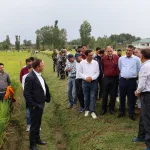Srinagar, Feb 13: In a concerning development, groundwater contamination is on the rise in Jammu and Kashmir, with several districts reporting alarming levels of pollutants that pose serious health risks.
According to the Annual Ground Water Quality Report-2024 released by the Central Ground Water Board (CGWB) under the Ministry of Jal Shakti, high levels of nitrate and arsenic have been detected in multiple districts of J&K, raising concerns over water safety for public consumption.
As per the report, nitrate levels above 45 mg/L were found in the groundwater of Baramulla, Jammu, Kathua, Kupwara, Rajouri and Samba. The report further notes that 9.2% of the wells tested in J&K contained nitrate concentrations beyond this level, underscoring the widespread nature of the contamination. The contamination is largely attributed to human activities such as overuse of fertilizers, agricultural runoff, and poor wastewater management, which allow harmful substances to seep into underground water sources.
Prolonged exposure to high nitrate levels can have severe health consequences. Medical experts warn that consuming nitrate-contaminated water increases the risk of methemoglobinemia, a condition that restricts oxygen flow in the blood. Symptoms include fatigue, dizziness, headaches, nausea, and, in severe cases, respiratory distress, irregular heartbeat and even coma or death.
Infants under six months are particularly vulnerable, as their bodies struggle to process nitrates efficiently. This can result in “blue baby syndrome”, a condition where a lack of oxygen causes a bluish skin tint. If left untreated, severe cases can lead to developmental issues and life-threatening complications.
In adults, prolonged nitrate exposure has been linked to digestive disorders, thyroid dysfunction, neurological problems, cardiovascular diseases, and an increased risk of certain cancers.
“Long-term exposure to high nitrate levels in drinking water can have devastating effects on human health. Besides increasing the risk of various cancers, it can interfere with oxygen transport in the blood, affecting brain function and cardiovascular health. It is crucial to implement regular water quality monitoring and take preventive measures to reduce contamination before it leads to a larger public health crisis,” said Dr Farooq, a senior doctor.
Apart from its effects on human health, nitrate contamination can also harm the environment. Excessive nitrate levels contribute to eutrophication, a process where nutrient overload leads to uncontrolled algae growth in water bodies. This depletes oxygen levels, harming aquatic life and disrupting ecosystems. In extreme cases, mass fish deaths and a decline in biodiversity can occur.
In addition to high nitrate content, the report also highlights arsenic contamination in Baramulla and Kupwara, where levels above 10 ppb have been recorded. Chronic arsenic exposure has been associated with skin disorders, neurological impairment, cardiovascular diseases, and a heightened risk of cancer.
While arsenic contamination is often attributed to natural geological processes, experts suggest that unregulated groundwater extraction and environmental changes may be worsening the issue.
Acknowledging these concerns, a senior official at the Jal Shakti (PHE) Department, requesting anonymity, said, “The rise in agricultural activities in recent years has impacted groundwater quality, mainly due to pesticide use. To address this, we have set up a new testing plant on a trial basis, using advanced biological oxidation technology to improve water purification. Currently, only one plant is operational, but if it proves effective, more will be installed to enhance monitoring and ensure safer water supply.”
“Alongside this initiative, we have intensified testing across various regions, with routine checks conducted pre- and post-monsoon to track any seasonal changes in water quality. With 53 testing laboratories across Kashmir, water from all areas undergoes thorough examination before reaching consumers. Our priority remains ensuring safe and clean drinking water for every resident,” he added.
While authorities have stepped up monitoring efforts, experts emphasize the need for long-term solutions to protect groundwater sources. Without swift intervention, the region risks irreversible damage to public health and local ecosystems








